Essay on Mental Health Stigma, Discrimination, and Nursing Roles
VerifiedAdded on 2023/01/12
|8
|1652
|74
Essay
AI Summary
This essay delves into the critical issues of stigma and discrimination faced by individuals with mental illnesses. It explores the negative behaviors and unfair beliefs of society, defining both social and self-stigma. The essay examines historical factors, causes, and types of stigma, including lack of awareness and cultural attitudes. It further discusses relevant legislative frameworks and standards designed to reduce stigma and discrimination, categorizing them into education, contact, and protest strategies. The core of the essay focuses on the role of mental health nurses in mitigating stigma through interventions such as active listening, communication, and cognitive behavioral therapy. It also highlights the importance of consumer and carer perspectives, emphasizing their roles in improving mental health services and outcomes. The essay concludes by summarizing the detrimental effects of stigma and the interventions that can improve the lives of those with mental illnesses.
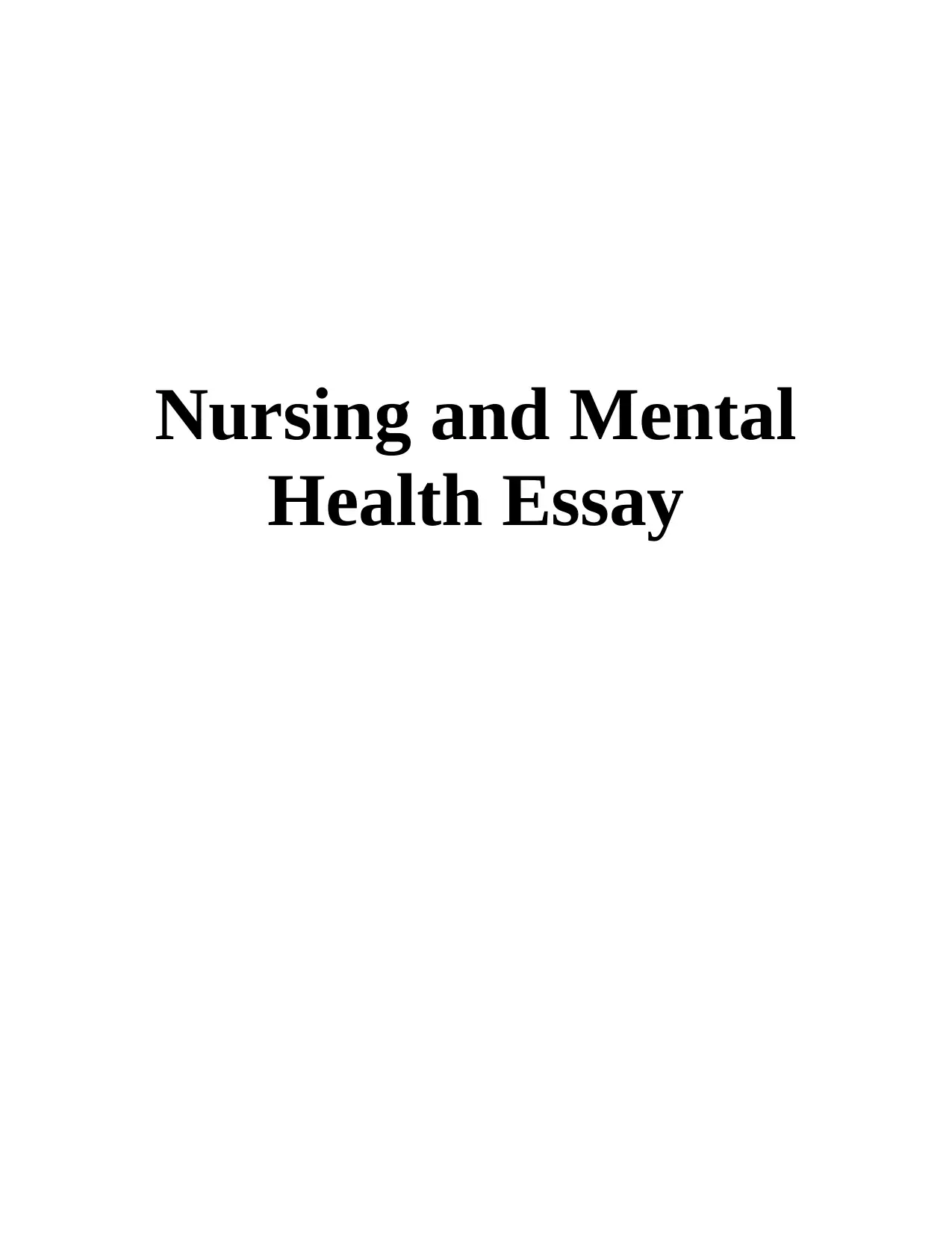
Nursing and Mental
Health Essay
Health Essay
Paraphrase This Document
Need a fresh take? Get an instant paraphrase of this document with our AI Paraphraser
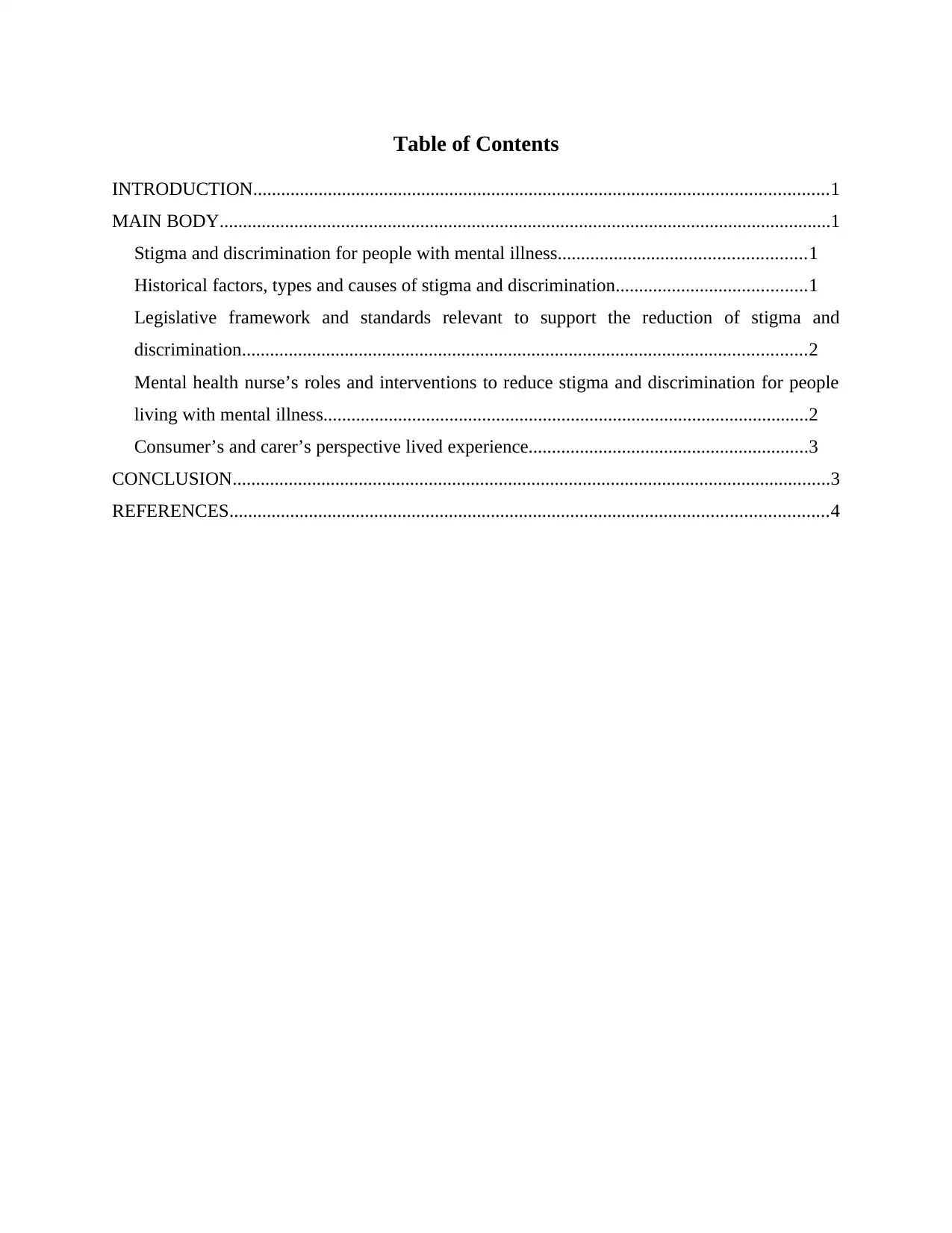
Table of Contents
INTRODUCTION...........................................................................................................................1
MAIN BODY...................................................................................................................................1
Stigma and discrimination for people with mental illness.....................................................1
Historical factors, types and causes of stigma and discrimination.........................................1
Legislative framework and standards relevant to support the reduction of stigma and
discrimination.........................................................................................................................2
Mental health nurse’s roles and interventions to reduce stigma and discrimination for people
living with mental illness........................................................................................................2
Consumer’s and carer’s perspective lived experience............................................................3
CONCLUSION................................................................................................................................3
REFERENCES................................................................................................................................4
INTRODUCTION...........................................................................................................................1
MAIN BODY...................................................................................................................................1
Stigma and discrimination for people with mental illness.....................................................1
Historical factors, types and causes of stigma and discrimination.........................................1
Legislative framework and standards relevant to support the reduction of stigma and
discrimination.........................................................................................................................2
Mental health nurse’s roles and interventions to reduce stigma and discrimination for people
living with mental illness........................................................................................................2
Consumer’s and carer’s perspective lived experience............................................................3
CONCLUSION................................................................................................................................3
REFERENCES................................................................................................................................4
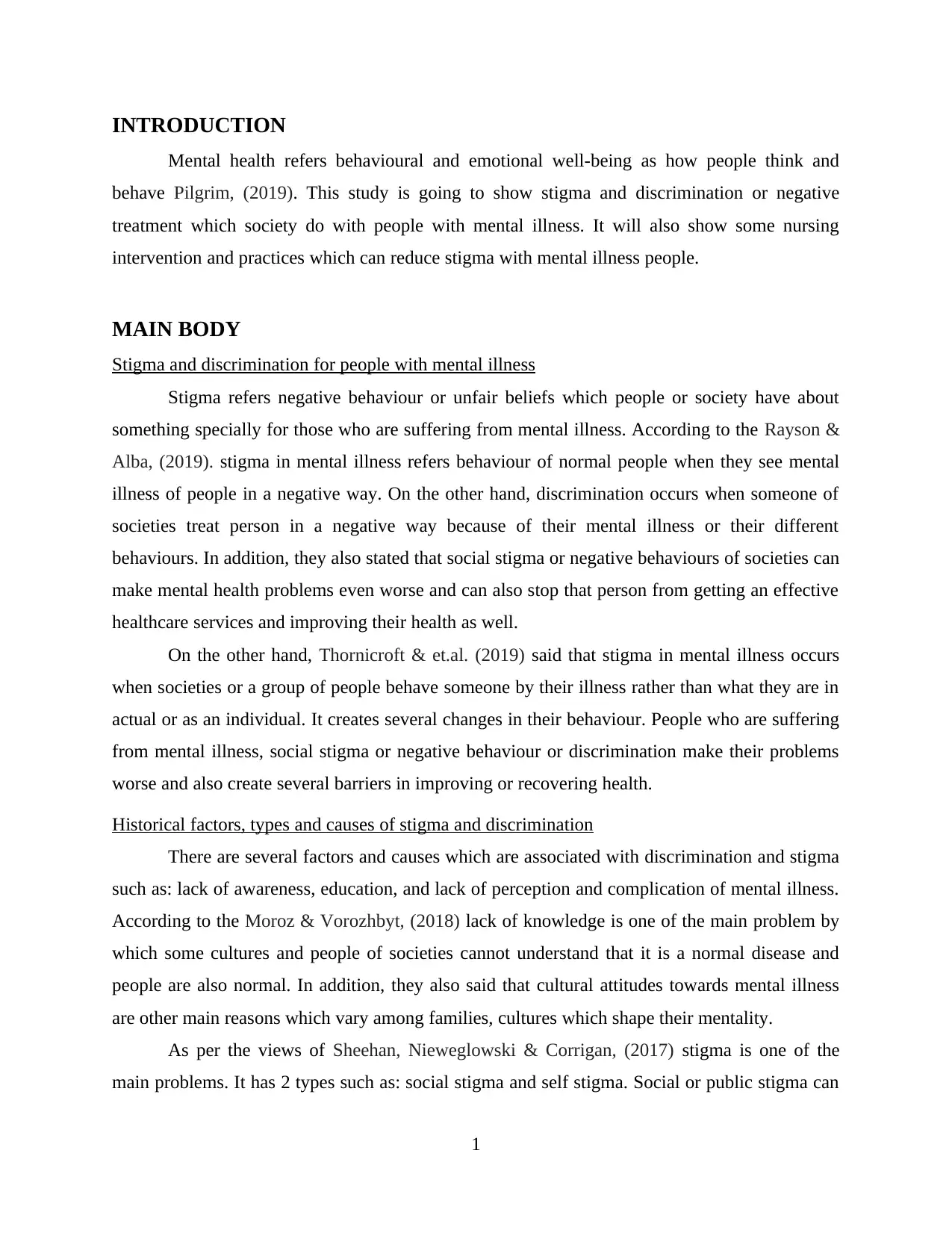
INTRODUCTION
Mental health refers behavioural and emotional well-being as how people think and
behave Pilgrim, (2019). This study is going to show stigma and discrimination or negative
treatment which society do with people with mental illness. It will also show some nursing
intervention and practices which can reduce stigma with mental illness people.
MAIN BODY
Stigma and discrimination for people with mental illness
Stigma refers negative behaviour or unfair beliefs which people or society have about
something specially for those who are suffering from mental illness. According to the Rayson &
Alba, (2019). stigma in mental illness refers behaviour of normal people when they see mental
illness of people in a negative way. On the other hand, discrimination occurs when someone of
societies treat person in a negative way because of their mental illness or their different
behaviours. In addition, they also stated that social stigma or negative behaviours of societies can
make mental health problems even worse and can also stop that person from getting an effective
healthcare services and improving their health as well.
On the other hand, Thornicroft & et.al. (2019) said that stigma in mental illness occurs
when societies or a group of people behave someone by their illness rather than what they are in
actual or as an individual. It creates several changes in their behaviour. People who are suffering
from mental illness, social stigma or negative behaviour or discrimination make their problems
worse and also create several barriers in improving or recovering health.
Historical factors, types and causes of stigma and discrimination
There are several factors and causes which are associated with discrimination and stigma
such as: lack of awareness, education, and lack of perception and complication of mental illness.
According to the Moroz & Vorozhbyt, (2018) lack of knowledge is one of the main problem by
which some cultures and people of societies cannot understand that it is a normal disease and
people are also normal. In addition, they also said that cultural attitudes towards mental illness
are other main reasons which vary among families, cultures which shape their mentality.
As per the views of Sheehan, Nieweglowski & Corrigan, (2017) stigma is one of the
main problems. It has 2 types such as: social stigma and self stigma. Social or public stigma can
1
Mental health refers behavioural and emotional well-being as how people think and
behave Pilgrim, (2019). This study is going to show stigma and discrimination or negative
treatment which society do with people with mental illness. It will also show some nursing
intervention and practices which can reduce stigma with mental illness people.
MAIN BODY
Stigma and discrimination for people with mental illness
Stigma refers negative behaviour or unfair beliefs which people or society have about
something specially for those who are suffering from mental illness. According to the Rayson &
Alba, (2019). stigma in mental illness refers behaviour of normal people when they see mental
illness of people in a negative way. On the other hand, discrimination occurs when someone of
societies treat person in a negative way because of their mental illness or their different
behaviours. In addition, they also stated that social stigma or negative behaviours of societies can
make mental health problems even worse and can also stop that person from getting an effective
healthcare services and improving their health as well.
On the other hand, Thornicroft & et.al. (2019) said that stigma in mental illness occurs
when societies or a group of people behave someone by their illness rather than what they are in
actual or as an individual. It creates several changes in their behaviour. People who are suffering
from mental illness, social stigma or negative behaviour or discrimination make their problems
worse and also create several barriers in improving or recovering health.
Historical factors, types and causes of stigma and discrimination
There are several factors and causes which are associated with discrimination and stigma
such as: lack of awareness, education, and lack of perception and complication of mental illness.
According to the Moroz & Vorozhbyt, (2018) lack of knowledge is one of the main problem by
which some cultures and people of societies cannot understand that it is a normal disease and
people are also normal. In addition, they also said that cultural attitudes towards mental illness
are other main reasons which vary among families, cultures which shape their mentality.
As per the views of Sheehan, Nieweglowski & Corrigan, (2017) stigma is one of the
main problems. It has 2 types such as: social stigma and self stigma. Social or public stigma can
1
⊘ This is a preview!⊘
Do you want full access?
Subscribe today to unlock all pages.

Trusted by 1+ million students worldwide
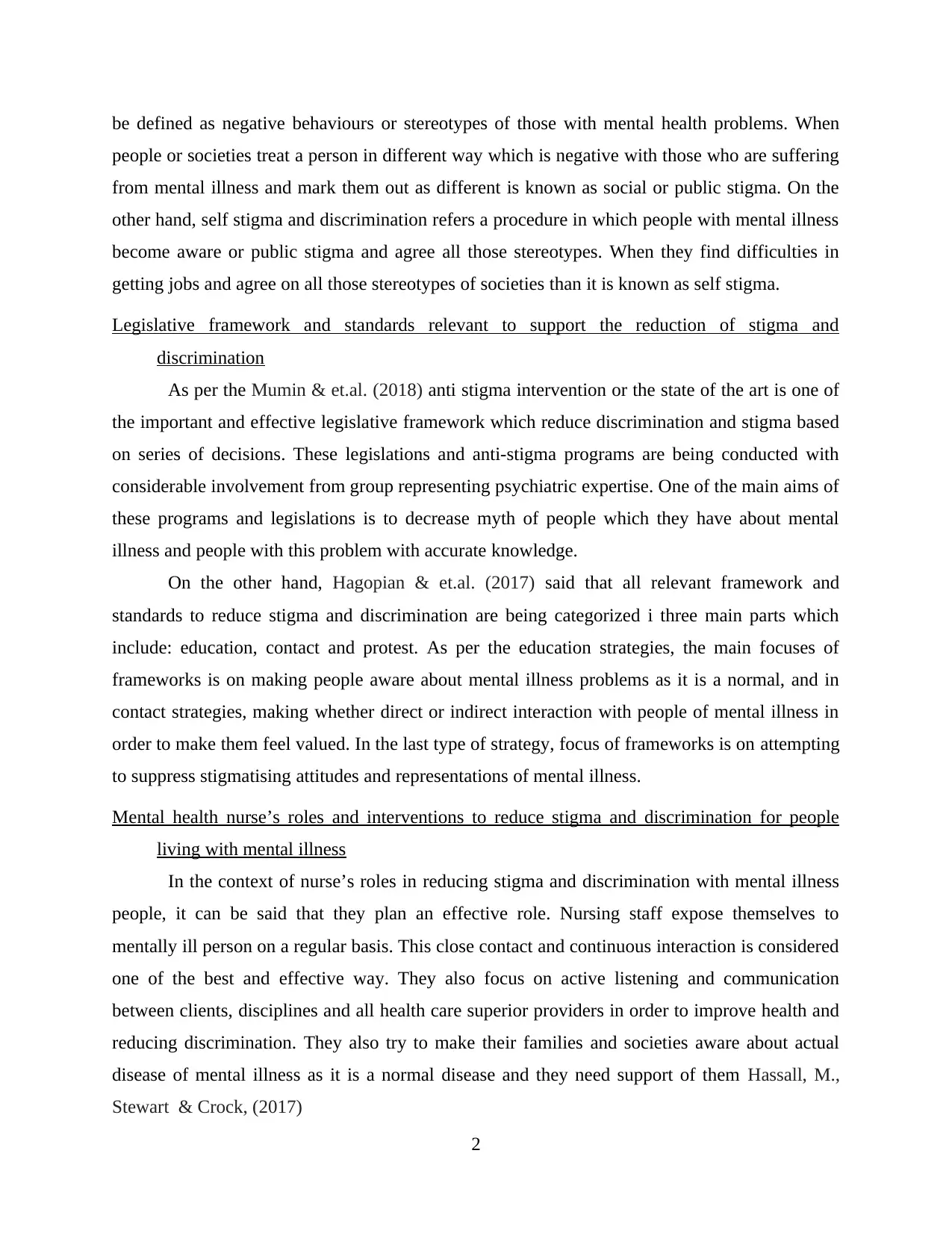
be defined as negative behaviours or stereotypes of those with mental health problems. When
people or societies treat a person in different way which is negative with those who are suffering
from mental illness and mark them out as different is known as social or public stigma. On the
other hand, self stigma and discrimination refers a procedure in which people with mental illness
become aware or public stigma and agree all those stereotypes. When they find difficulties in
getting jobs and agree on all those stereotypes of societies than it is known as self stigma.
Legislative framework and standards relevant to support the reduction of stigma and
discrimination
As per the Mumin & et.al. (2018) anti stigma intervention or the state of the art is one of
the important and effective legislative framework which reduce discrimination and stigma based
on series of decisions. These legislations and anti-stigma programs are being conducted with
considerable involvement from group representing psychiatric expertise. One of the main aims of
these programs and legislations is to decrease myth of people which they have about mental
illness and people with this problem with accurate knowledge.
On the other hand, Hagopian & et.al. (2017) said that all relevant framework and
standards to reduce stigma and discrimination are being categorized i three main parts which
include: education, contact and protest. As per the education strategies, the main focuses of
frameworks is on making people aware about mental illness problems as it is a normal, and in
contact strategies, making whether direct or indirect interaction with people of mental illness in
order to make them feel valued. In the last type of strategy, focus of frameworks is on attempting
to suppress stigmatising attitudes and representations of mental illness.
Mental health nurse’s roles and interventions to reduce stigma and discrimination for people
living with mental illness
In the context of nurse’s roles in reducing stigma and discrimination with mental illness
people, it can be said that they plan an effective role. Nursing staff expose themselves to
mentally ill person on a regular basis. This close contact and continuous interaction is considered
one of the best and effective way. They also focus on active listening and communication
between clients, disciplines and all health care superior providers in order to improve health and
reducing discrimination. They also try to make their families and societies aware about actual
disease of mental illness as it is a normal disease and they need support of them Hassall, M.,
Stewart & Crock, (2017)
2
people or societies treat a person in different way which is negative with those who are suffering
from mental illness and mark them out as different is known as social or public stigma. On the
other hand, self stigma and discrimination refers a procedure in which people with mental illness
become aware or public stigma and agree all those stereotypes. When they find difficulties in
getting jobs and agree on all those stereotypes of societies than it is known as self stigma.
Legislative framework and standards relevant to support the reduction of stigma and
discrimination
As per the Mumin & et.al. (2018) anti stigma intervention or the state of the art is one of
the important and effective legislative framework which reduce discrimination and stigma based
on series of decisions. These legislations and anti-stigma programs are being conducted with
considerable involvement from group representing psychiatric expertise. One of the main aims of
these programs and legislations is to decrease myth of people which they have about mental
illness and people with this problem with accurate knowledge.
On the other hand, Hagopian & et.al. (2017) said that all relevant framework and
standards to reduce stigma and discrimination are being categorized i three main parts which
include: education, contact and protest. As per the education strategies, the main focuses of
frameworks is on making people aware about mental illness problems as it is a normal, and in
contact strategies, making whether direct or indirect interaction with people of mental illness in
order to make them feel valued. In the last type of strategy, focus of frameworks is on attempting
to suppress stigmatising attitudes and representations of mental illness.
Mental health nurse’s roles and interventions to reduce stigma and discrimination for people
living with mental illness
In the context of nurse’s roles in reducing stigma and discrimination with mental illness
people, it can be said that they plan an effective role. Nursing staff expose themselves to
mentally ill person on a regular basis. This close contact and continuous interaction is considered
one of the best and effective way. They also focus on active listening and communication
between clients, disciplines and all health care superior providers in order to improve health and
reducing discrimination. They also try to make their families and societies aware about actual
disease of mental illness as it is a normal disease and they need support of them Hassall, M.,
Stewart & Crock, (2017)
2
Paraphrase This Document
Need a fresh take? Get an instant paraphrase of this document with our AI Paraphraser
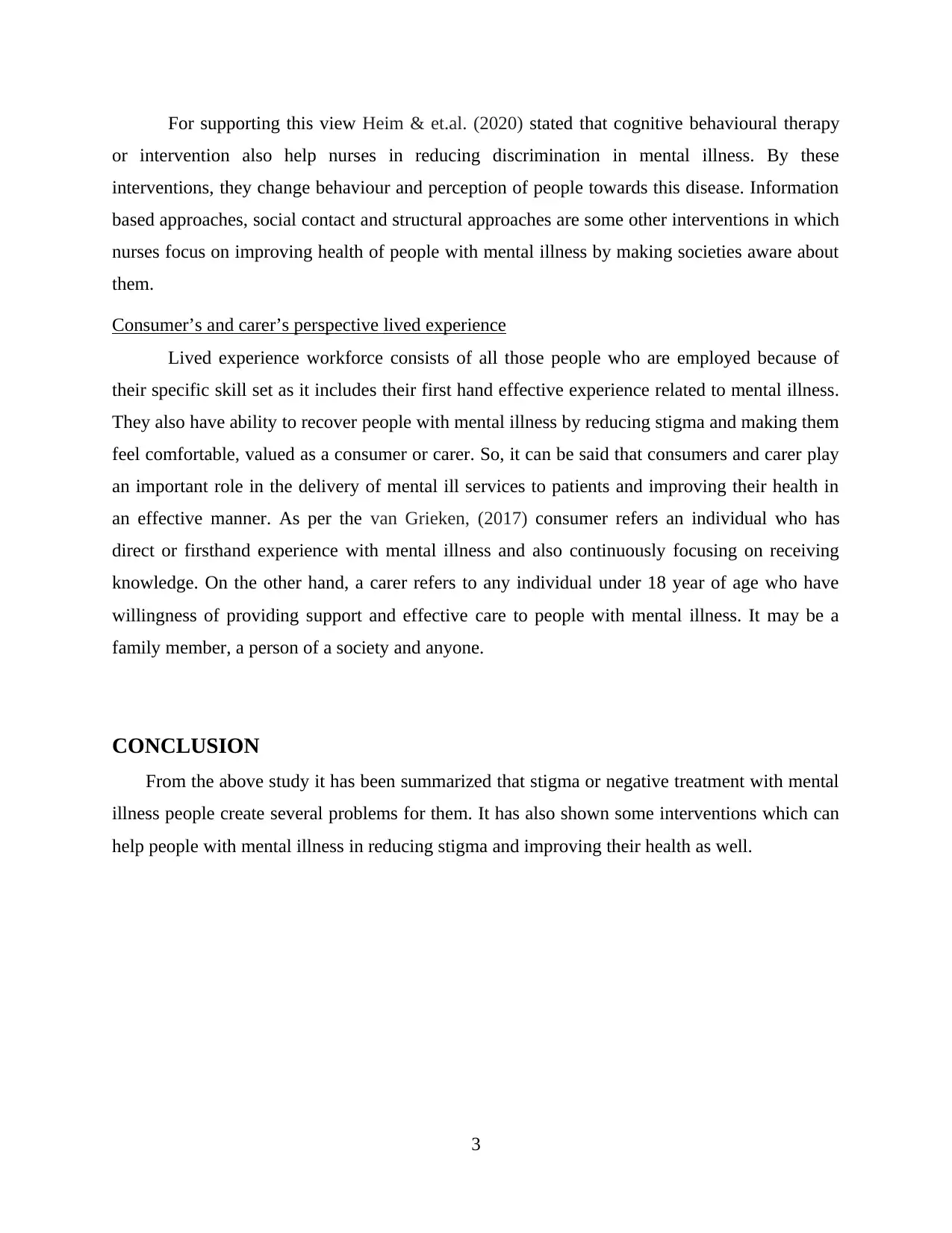
For supporting this view Heim & et.al. (2020) stated that cognitive behavioural therapy
or intervention also help nurses in reducing discrimination in mental illness. By these
interventions, they change behaviour and perception of people towards this disease. Information
based approaches, social contact and structural approaches are some other interventions in which
nurses focus on improving health of people with mental illness by making societies aware about
them.
Consumer’s and carer’s perspective lived experience
Lived experience workforce consists of all those people who are employed because of
their specific skill set as it includes their first hand effective experience related to mental illness.
They also have ability to recover people with mental illness by reducing stigma and making them
feel comfortable, valued as a consumer or carer. So, it can be said that consumers and carer play
an important role in the delivery of mental ill services to patients and improving their health in
an effective manner. As per the van Grieken, (2017) consumer refers an individual who has
direct or firsthand experience with mental illness and also continuously focusing on receiving
knowledge. On the other hand, a carer refers to any individual under 18 year of age who have
willingness of providing support and effective care to people with mental illness. It may be a
family member, a person of a society and anyone.
CONCLUSION
From the above study it has been summarized that stigma or negative treatment with mental
illness people create several problems for them. It has also shown some interventions which can
help people with mental illness in reducing stigma and improving their health as well.
3
or intervention also help nurses in reducing discrimination in mental illness. By these
interventions, they change behaviour and perception of people towards this disease. Information
based approaches, social contact and structural approaches are some other interventions in which
nurses focus on improving health of people with mental illness by making societies aware about
them.
Consumer’s and carer’s perspective lived experience
Lived experience workforce consists of all those people who are employed because of
their specific skill set as it includes their first hand effective experience related to mental illness.
They also have ability to recover people with mental illness by reducing stigma and making them
feel comfortable, valued as a consumer or carer. So, it can be said that consumers and carer play
an important role in the delivery of mental ill services to patients and improving their health in
an effective manner. As per the van Grieken, (2017) consumer refers an individual who has
direct or firsthand experience with mental illness and also continuously focusing on receiving
knowledge. On the other hand, a carer refers to any individual under 18 year of age who have
willingness of providing support and effective care to people with mental illness. It may be a
family member, a person of a society and anyone.
CONCLUSION
From the above study it has been summarized that stigma or negative treatment with mental
illness people create several problems for them. It has also shown some interventions which can
help people with mental illness in reducing stigma and improving their health as well.
3
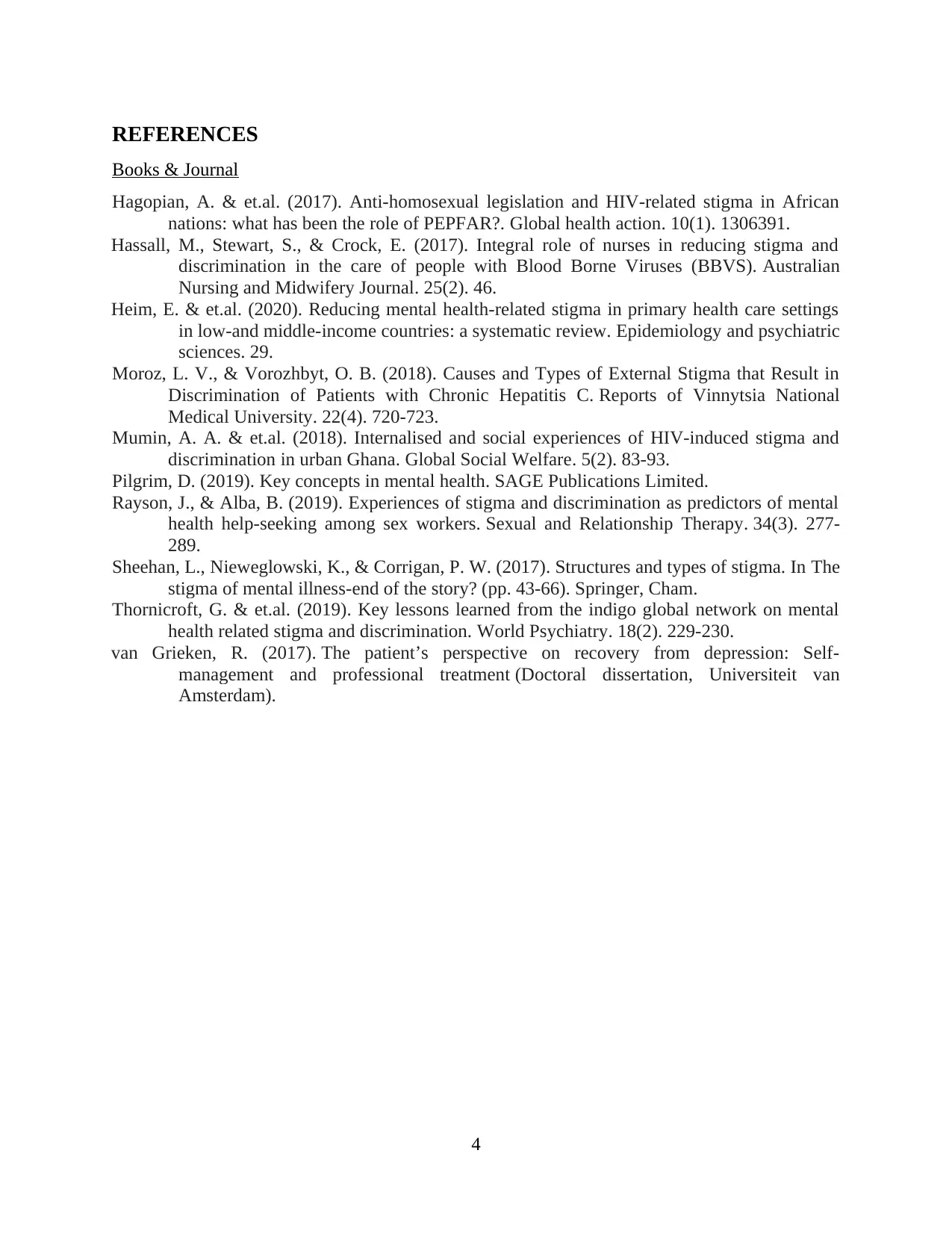
REFERENCES
Books & Journal
Hagopian, A. & et.al. (2017). Anti-homosexual legislation and HIV-related stigma in African
nations: what has been the role of PEPFAR?. Global health action. 10(1). 1306391.
Hassall, M., Stewart, S., & Crock, E. (2017). Integral role of nurses in reducing stigma and
discrimination in the care of people with Blood Borne Viruses (BBVS). Australian
Nursing and Midwifery Journal. 25(2). 46.
Heim, E. & et.al. (2020). Reducing mental health-related stigma in primary health care settings
in low-and middle-income countries: a systematic review. Epidemiology and psychiatric
sciences. 29.
Moroz, L. V., & Vorozhbyt, O. B. (2018). Causes and Types of External Stigma that Result in
Discrimination of Patients with Chronic Hepatitis C. Reports of Vinnytsia National
Medical University. 22(4). 720-723.
Mumin, A. A. & et.al. (2018). Internalised and social experiences of HIV-induced stigma and
discrimination in urban Ghana. Global Social Welfare. 5(2). 83-93.
Pilgrim, D. (2019). Key concepts in mental health. SAGE Publications Limited.
Rayson, J., & Alba, B. (2019). Experiences of stigma and discrimination as predictors of mental
health help-seeking among sex workers. Sexual and Relationship Therapy. 34(3). 277-
289.
Sheehan, L., Nieweglowski, K., & Corrigan, P. W. (2017). Structures and types of stigma. In The
stigma of mental illness-end of the story? (pp. 43-66). Springer, Cham.
Thornicroft, G. & et.al. (2019). Key lessons learned from the indigo global network on mental
health related stigma and discrimination. World Psychiatry. 18(2). 229-230.
van Grieken, R. (2017). The patient’s perspective on recovery from depression: Self-
management and professional treatment (Doctoral dissertation, Universiteit van
Amsterdam).
4
Books & Journal
Hagopian, A. & et.al. (2017). Anti-homosexual legislation and HIV-related stigma in African
nations: what has been the role of PEPFAR?. Global health action. 10(1). 1306391.
Hassall, M., Stewart, S., & Crock, E. (2017). Integral role of nurses in reducing stigma and
discrimination in the care of people with Blood Borne Viruses (BBVS). Australian
Nursing and Midwifery Journal. 25(2). 46.
Heim, E. & et.al. (2020). Reducing mental health-related stigma in primary health care settings
in low-and middle-income countries: a systematic review. Epidemiology and psychiatric
sciences. 29.
Moroz, L. V., & Vorozhbyt, O. B. (2018). Causes and Types of External Stigma that Result in
Discrimination of Patients with Chronic Hepatitis C. Reports of Vinnytsia National
Medical University. 22(4). 720-723.
Mumin, A. A. & et.al. (2018). Internalised and social experiences of HIV-induced stigma and
discrimination in urban Ghana. Global Social Welfare. 5(2). 83-93.
Pilgrim, D. (2019). Key concepts in mental health. SAGE Publications Limited.
Rayson, J., & Alba, B. (2019). Experiences of stigma and discrimination as predictors of mental
health help-seeking among sex workers. Sexual and Relationship Therapy. 34(3). 277-
289.
Sheehan, L., Nieweglowski, K., & Corrigan, P. W. (2017). Structures and types of stigma. In The
stigma of mental illness-end of the story? (pp. 43-66). Springer, Cham.
Thornicroft, G. & et.al. (2019). Key lessons learned from the indigo global network on mental
health related stigma and discrimination. World Psychiatry. 18(2). 229-230.
van Grieken, R. (2017). The patient’s perspective on recovery from depression: Self-
management and professional treatment (Doctoral dissertation, Universiteit van
Amsterdam).
4
⊘ This is a preview!⊘
Do you want full access?
Subscribe today to unlock all pages.

Trusted by 1+ million students worldwide

Paraphrase This Document
Need a fresh take? Get an instant paraphrase of this document with our AI Paraphraser

1
1 out of 8
Related Documents
Your All-in-One AI-Powered Toolkit for Academic Success.
+13062052269
info@desklib.com
Available 24*7 on WhatsApp / Email
![[object Object]](/_next/static/media/star-bottom.7253800d.svg)
Unlock your academic potential
Copyright © 2020–2025 A2Z Services. All Rights Reserved. Developed and managed by ZUCOL.





